Website consists of pages connected with internal links. Connecting links forming hierarchical architecture like pyramid site structure will boost your SEO. We have reviewed several site structures and found that pyramid is the best one for SEO.
Now there are many ways to apply pyramid site structure in WordPress. We need to choose the optimal one and stick to it.
In this article you will learn:
- Ways to apply pyramid site structure in WordPress.
- Clean up WordPress from useless links and pages.
- Analyze site structure before and after optimization.
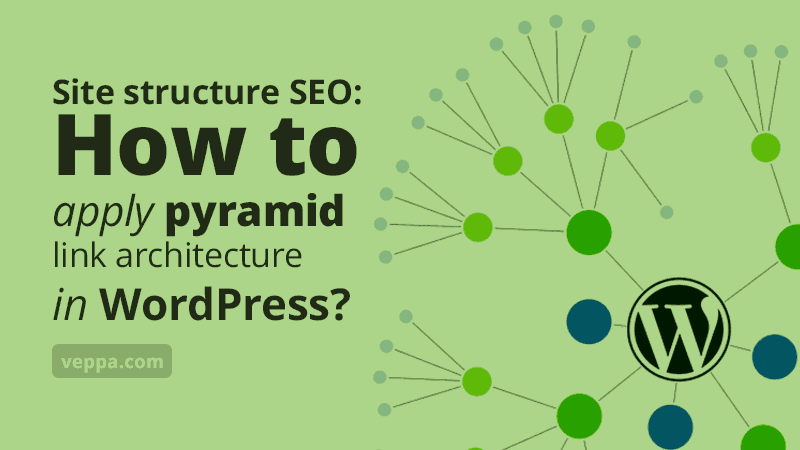
Table of Contents
Analyze existing site structure
Before starting to apply we need to see the current state of link structure. I will use a copy of my existing blog data with default Twenty Twenty One theme (theme used by 1+ million blogs) and widgets. This is a common widget setup that is used by blogs.
Blog has following records:
- 49 posts
- 32 pages
- Forum
- 49 forum topics
- 70 forum topic replies
- 52 topic tags
- 13 post categories
- 27 date archives
- 6 tags
- 1 blog author
- 5 widgets
Check site-wide menu navigation and widgets
Pay attention to pages with repeated content like latest posts, archive of all posts, list of popular posts.
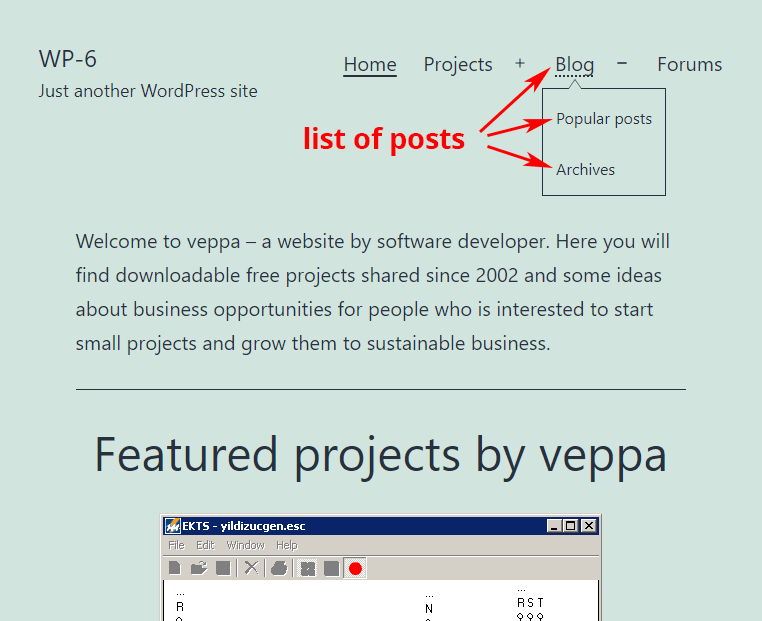
This is a regular top menu linking to important pages on the blog. Also it has 3 pages that lists posts in different order.
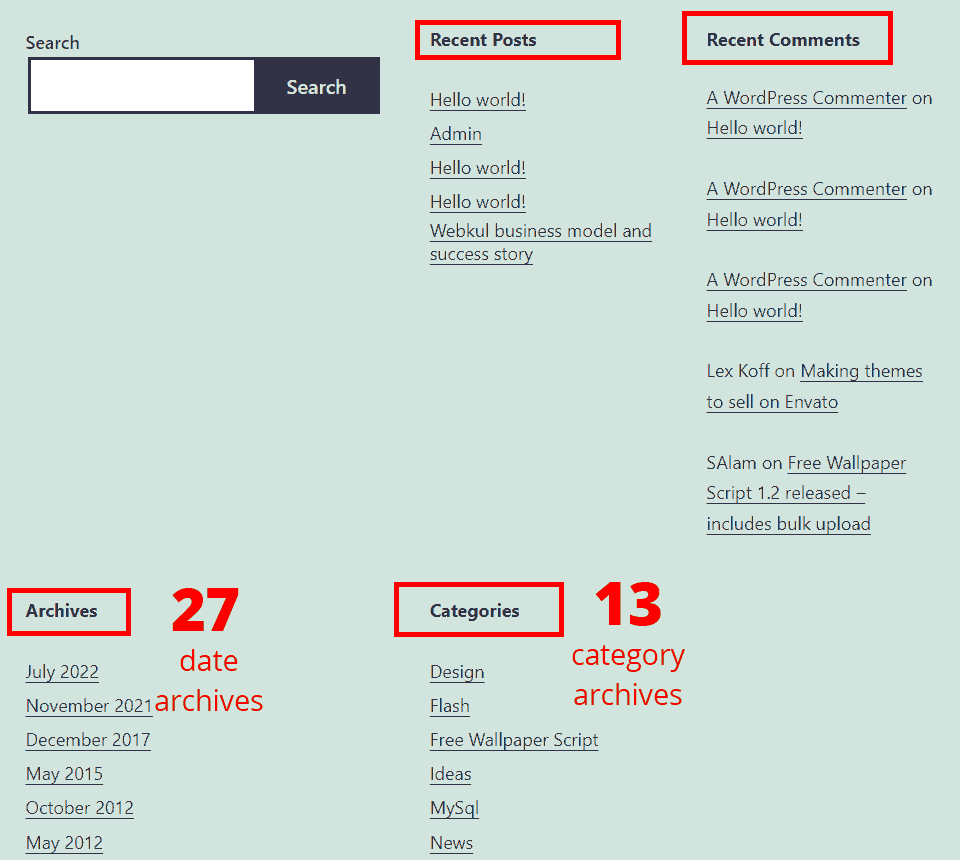
This is the bottom of a blog with 5 widgets. It has
- search form
- 5 recent posts
- 5 recent comments
- 27 date archives
- 13 categories
These widgets are loaded on all pages. We will clean up widgets later in this article.
Check site structure and crawl depth using SEO tool
Now let’s analyze the current site structure with a free version of Screaming Frog software. Which is listed in our free SEO tools list.
Take note of the crawl depth graph and number of nodes. Compare the number of nodes to the number of content pages in your WordPress blog.
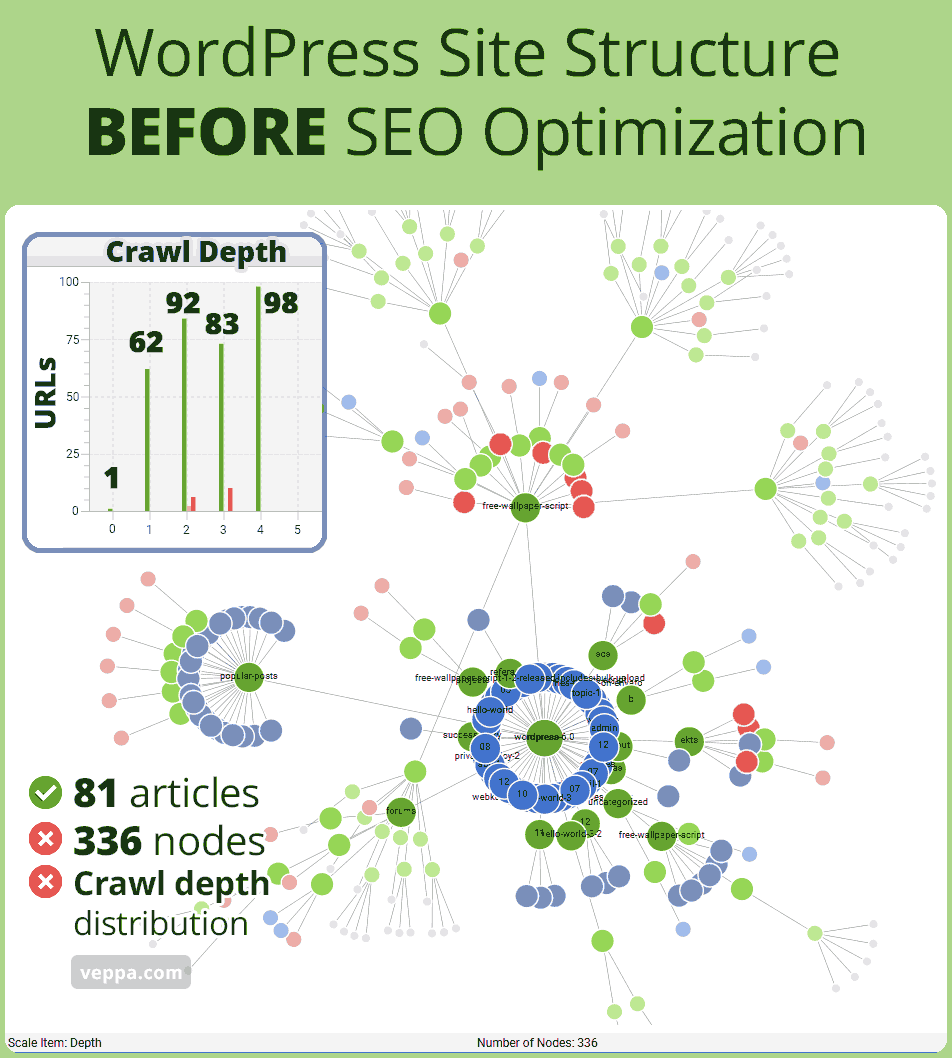
Screenshot from Screaming Frog “Visualization” → “Force-directed crawl diagram” menu.
- Crawl depth distribution is not increasing linearly. 62 pages are too many for the first level. Level 3 has 83 pages which is less than level 2 of 92 pages. This is not expected in pyramid site structure.
- Number of nodes is 4 times more than the number of article pages. Those are pages with low value content like date archives, tags, categories, duplicate pages and forums. Ideally we should have nodes more than pages around 1.2 times. Expected around 100 nodes for 81 pages.
How to fix this site structure:
- Remove pages with no SEO value.
- Clean up sidebars and remove useless links.
- Reduce the number of links on the home page.
Create pyramid site structure in WordPress
Pyramid site structure links to 5-10 main topics from the home page. Each topic expands to 10 sub topics. Each subtopic expands to 10 long tail articles. In total it will be 500 articles. This is an ideal pyramid structure.
In our example site we have 81 articles. So our pyramid structure will be like the following. 4 main topics. Each topic will have 4 sub topics. Each sub topic will have 5 long tail articles. Over time the blog should expand to 500 articles.
Now lets structure our site to fit pyramid architecture with existing content. Also give the ability to grow to 500 articles without breaking site structure.
Choose content type for applying site structure
Currently our demo site has 81 articles. We project to have 500 articles in order to cover all aspects in our niche.
Criteria when applying site structure for WordPress blog:
- Flexible Depth (level): In the ideal pyramid we have 4 levels including the home page. This can expand to 5 levels or shrink to 3 levels for any particular main topic. Some topics may reach 3 levels, others 4 or 5.
Preferred WordPress content type: page or post. - Flexible position: any article can go up or down the level in future. Also any article can change its parent or children. Permalink should stay the same when any article changes its position. Site structure should not use hard hierarchy URL like
/topic/subtopic/long-tail-article/. Because if you change/topic/permalink all its children will lose SEO rank.
Preferred WordPress content type: posts or pages without parent & children. - Sense of active blog: Blog attracts regular users with always updated content. All content should also be accessible in chronological form. Latest updated articles should be viewable by regular users. This breaks the pyramid site structure but uses
noindexfor the latest blog posts page.
Preferred WordPress content type: posts.
According to all these criteria our pyramid site structure should be applied with WordPress posts.
Why is the sense of active blog (latest posts) important?
Latest posts are important because we regularly (daily or weekly) visit our favorite blogs to learn and apply something new. This is like a daily challenge. Without the latest posts blog will look boring, like a corporate static website without any activity.
3 options to apply pyramid site structure:
Option 1: Page (5 topic) → Page (50 sub topic) → Page (500 long tail article).
Pros:
- Default WordPress feature to apply hierarchical pyramid site structure with parent and child pages.
- Easy to view hierarchy in WordPress admin panel.
Cons:
- Permalinks will form a hard site structure. When permalink changes in future will lose all SEO value collected until that time. Very bad.
- You still have to manually link to parent and to children manually inside article content. No automatic linking.
- No sense of active blog. Site will look boring and too corporate. Because pages are not listed in chronological order.
Option 2: Page (5 topic)→ Category (50 sub topic) → Post (500 long tail article).
Pros:
- Easy to apply and manage.
- All children links in the category are built automatically.
- Link to category (sub topic) from post (long tail article) built automatically.
Cons:
- Not flexible if you want to change the depth of any article. Category cannot be a long tail article without any children.
- 50 categories is too many. Pages or posts can outrank most category pages in search engine results.
- Category pages do not have a single call to action option.
- Users spend 10x less time on category pages compared to other content pages.
Option 3: Page ( + noindex category optional) (5 topic) → Post (50 sub topic) → Post (500 long tail articles).
Pros:
- Flexible depth and position: any content can move anywhere without changing URL and losing SEO rank.
- Can list latest posts in chronological order for sense of blog activity.
Cons:
- Links to the parent and children should be added manually to every content.
- Link to main category, previous and next post can break site hierarchy. We need to remove those links from the blog using theme features.
I will use option 3 (page + post + post) option because it is flexible and meets all criteria for applying pyramid site structure. Link mess generated by previous next post links and link to category can be fixed by using a flexible theme that supports removing them.
Clean up WordPress link mess
We are going to use pages for the main topic. Create categories that match the main topic but have noindex attribute. Use posts for all sub topics and long tail articles.
Now we know how we are going to build the pyramid site structure we need to remove (clean up) everything else from our WordPress blog. We will remove excess post listing pages, unused taxonomies, author pages for single author blogs, forum or any other custom content that is not providing any SEO benefit, widgets that mess our link structure and content prioritization.
Remove tags
This one is an easy one. Usually people believe that using your focus keywords as tags will help for SEO. It is not right because your focus keyword should be targeted only for one content on your blog. When you use the same keyword for post and tag or category none of your content will not rank for that keyword. It will confuse google.
Listing your posts in several tags and categories will be considered as duplicate content. So it is advised to remove tags for niche sites with up to 1000 articles.
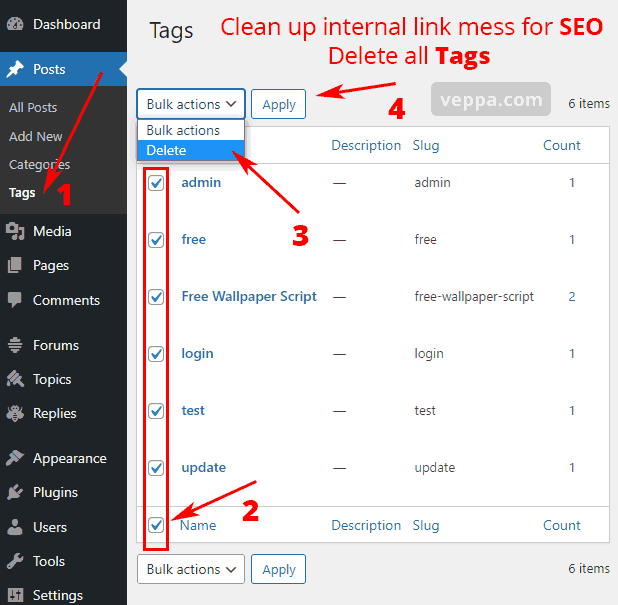
To remove all tags:
- Navigate to “Posts” → “Tags” from the WordPress admin panel.
- Select all tags by checking the checkbox from the table header or footer.
- Select the “Delete” option from the “Bulk actions” select box.
- Click the “Apply” button.
As you can see from the screenshot most tags have only one or two content in them.
Disable and Remove date archives
Date archives are an automatic WordPress feature that lists posts for a given month and year. It has no SEO or user advantage. There is a clear purpose to view posts for a particular date.
It is not enough to just remove a widget with date archives. You have to remove date archive pages from WordPress itself. Because google can index date archives from your old links or some other unknown sources.
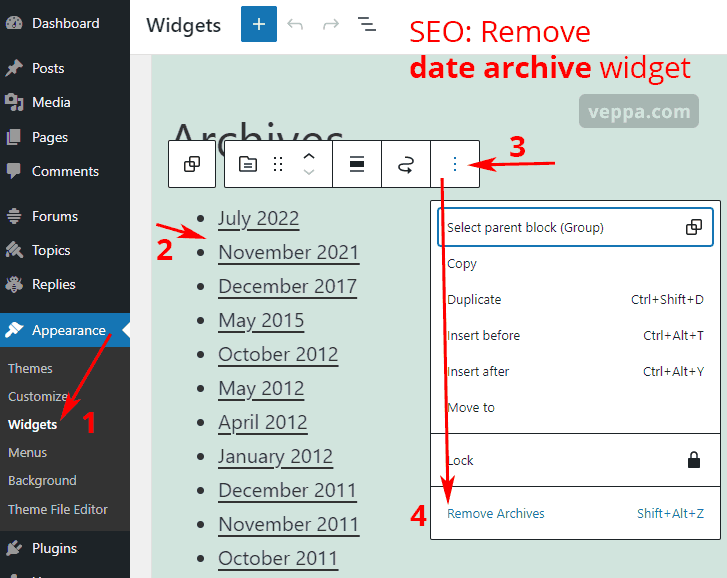
If you have date archives widget added on your blog then you can remove it by:
- Navigate to “Appearance” → “Widgets” page from WordPress dashboard.
- Find a related widget and click on it.
- Widget editing controls will appear. Click on 3 vertical dots and the dropdown menu will open.
- Click on the “Remove Archives” menu item.
Having a date archive in a widget will break your site structure because links will appear on all pages of your blog and they have no real benefit for users and SEO.
You need also remove actual date archive pages. To disable date archives use the Rank Math SEO plugin. Other popular SEO plugins like Yoast also should have such features.
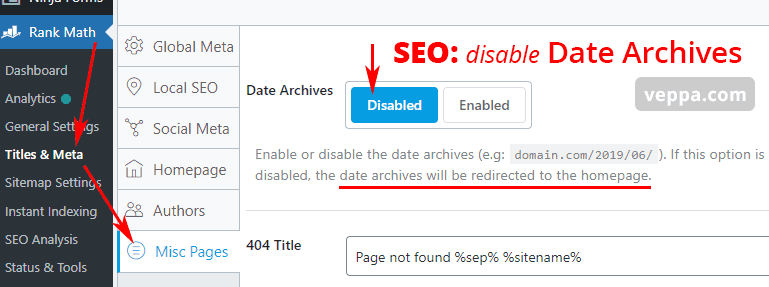
To disable date archives in WordPress and redirect existing page ranks to home page:
- Navigate to “Rank Math” → “Titles & Meta” → “Misc Pages”.
- Click on the “Disabled” button next to “Date Archives”.
- Click the “Save Changes” button at the end of the page.
Remove author archive on single author blog
When you have a single author blog there is no point in having an author page. Because it will be the exact same page as your latest blog posts page and be considered a duplicate page. We know that duplicate pages are bad for SEO. So remove author pages from WordPress. We will use the Rank Math SEO plugin for removing author pages.
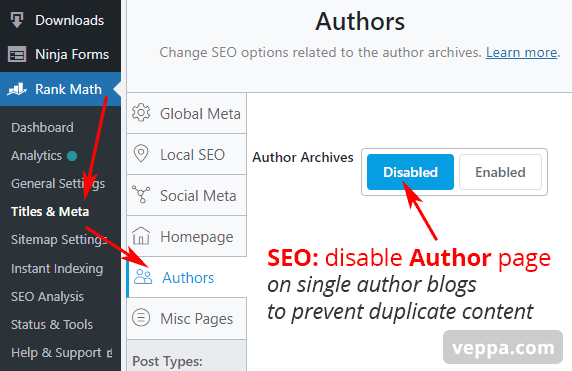
To prevent duplicate content and remove link mess disable author archives on WordPress by:
- Navigate to “Rank Math” → “Titles & Meta” → “Authors” page on WordPress dashboard.
- Select the “Disabled” option for “Author Archives”.
- Click “Save Changes” at the bottom of the page.
For multi author blogs use noindex robots meta tag for author pages. Noindex option will be visible when you select “Enabled” on the same page.
Remove latest posts from sidebar
Latest posts can be displayed on the home page. You do not need to show it on all pages. So remove it from the sidebar for not weakening link juice from all pages. Because your latest posts are not relevant to all articles on your WordPress blog.
It is good to have the latest posts as separate pages with pagination. Preferable noindex latest posts page. It is for regular site visitors to find latest added or updated articles and follow advice on those pages. It is the dynamic part of your blog.
Remove latest posts from sidebar widgets using the same instructions as explained in removing date archives from sidebar.
Remove recent comments from sidebar
Recent comments will also show that your blog is active and drive attention to active articles. But it is not advised to show the latest comments in the sidebar. Because the sidebar will show on all pages. Instead you can show the latest comments on your homepage or do not show at all.
Remove latest comments from sidebar widgets using the same instructions as explained in removing date archives from sidebar.
Remove categories from sidebar widget
We chose a strategy where categories are not used for site structure. So there is no point having categories in sidebars. Instead main topics will be used at the first level of our pyramid site structure.
Also in our chosen strategy we can use categories as helpers for grouping content for the main topic. Having main 5 categories will prevent posts from being forced to “uncategorized” category. But we are not going to link to category pages explicitly in sidebar widgets.
For this reason we will remove categories from sidebar widgets if they appear on sidebars.
Remove categories widget from sidebar using same instructions as explained in removing date archives from sidebar.
Remove previous & next, post author, post category links from theme
All posts have previous and next links. But they are not relevant to all posts. Imagine you are publishing posts to each main topic. And previous & next links will link to articles from each separate main topic. They will not have topical relevance. And they will break your pyramid site structure.
Fortunately some themes have the option to remove the default WordPress feature linking to previous and next articles.
We will also remove links to post authors because we are optimizing using a single author blog. Link to the post category also will be removed because we do not want to make category pages important for SEO. Instead main topic pages should be important pages on our blog.
Themes where you can disable previous & next, post author, post category links: Neve (I currently use this theme on my blog), Astra.
Themes without previous & next, post author, post category links: Hello Elementor.
This is optional optimization. It will clean up some link mess. If you prefer using your existing theme then it is fine.
For this tutorial I will use the Hello Elementor theme so that I do not have to play with settings to remove previous next, post author, post category links. We will just install and use themes. It will be optimized automatically.
Remove not used blog content like forums
I have used forums in the past for some discussion on my old flash projects. Now those projects are not used, so is the forum on my website. I can safely remove forums from my blog and further optimize WordPress site structure for SEO.
You can remove any unused features like forum by just deactivating and removing related plugins. Also remember to clean up WordPress after removing unused plugins. Cleaning up databases will make your blog faster.
Create site structure map and apply it to your WordPress site
Now it is time to actually create a site map in any text editor that will show the place for every blog post and page on your website. Use ordered list to see number of articles in each parent. This will help you to find useless content and missing content as well.
Example of creating site structure map with ordered list:
- Main topic 1
- Sub topic 1
- Long tail article 1
- Long tail article 2
- Long tail article 3
- …
- Sub topic 2
- Sub topic 3
- …
- Sub topic 1
- Main topic 2
- Main topic 3
- …
You can even create site structure map in WordPress and save it as draft or save as protected post so it is not visible publicly. Each item is title or URL of your article. Link to actual article and use it to navigate to it for adding corresponding parent and child links.
Use this structure as map to create new content and linking articles. Try to keep your site structure clean.
List of all URLs for pages and posts can be found in yoursite.com/sitemap.xml file.
For the purpose of this tutorial I will not spend time analyzing every post and page on my website. I will just randomly group content and distribute articles evenly. Using 81 posts & pages I created 4 topics. Each topic links to parent and to 3-4 child subtopics. Each sub topic links to 3-4 long tail articles.
Guide for applying pyramid site structure for SEO
- All links should be contextual.
- Every page should link to only one parent. Link to parent preferably at the beginning of the article. In the first 2 paragraphs.
- Every page should link to all children. No linking to grandchildren.
- Do not link to siblings or other parents. You can break this rule only if it really makes sense linking outside of related parent and children.
- Use main topics (no more than 5-10) in main navigation and on the home page. You can also link to main topics in sidebar widgets if you want. They will get 100% links from all pages.
- Parents should be a broader topic. Children should be more specific about long tail articles.
- Keep balance between number of articles in main topic. Do not allow one main topic to get 70% of your articles.
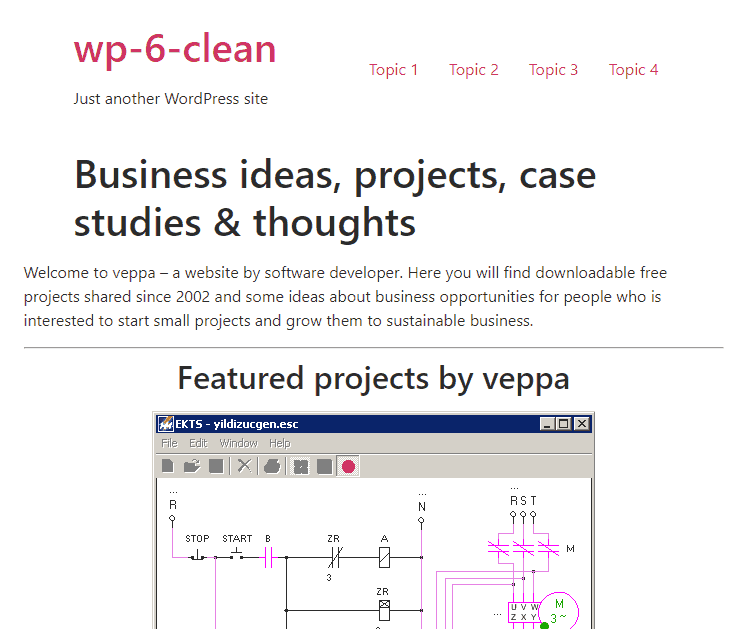
This is how the home page looks after applying optimization and switching to a clean theme (Hello Elementor) without previous & next links. Top navigation menu is simplified linking to 4 main topics. Because this is a demo site I used placeholder text for actual topic names. On live sites use SEO targeted main topic names.
Review updated site structure
We cleaned up default WordPress features and removed unused plugins, navigation, and duplicate pages. We also applied pyramid site structure inside each article linking only to one parent and to all children. From post page we removed linking to category pages and linking to previous & next posts.
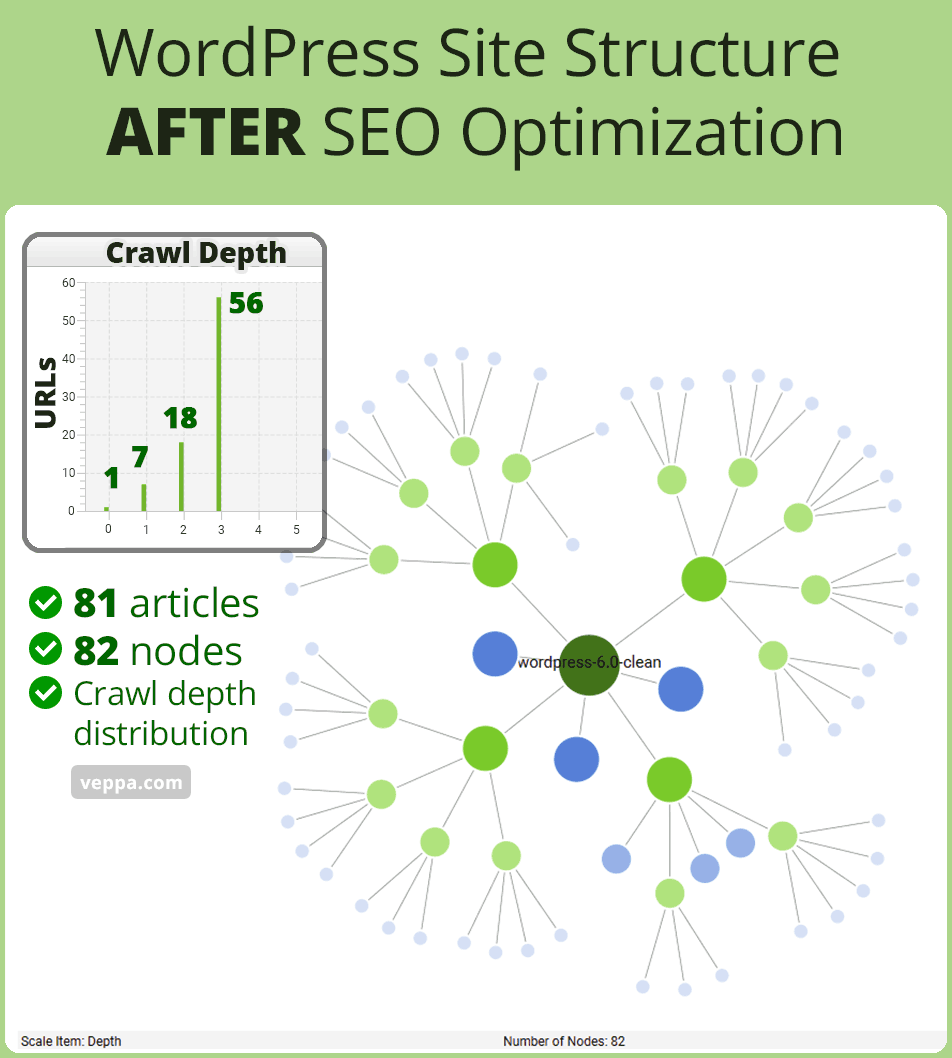
Final site is analyzed with Screaming Frog software. Check this site structure diagram generated using the “Force-directed crawl diagram” menu.
Those 3 big blue dots around home page are mandatory pages for any blog: “About us”, “Contact”, “Privacy policy”. They will not break your pyramid site structure.
What we have achieved:
- Number of nodes equal to number of pages. No useless page without any purpose on the website.
- Crawl depth distribution increases evenly. Every next level has more pages.
- All pages can be accessed and linked hierarchically.
FAQ
Is there an automated way of creating pyramid site structure in WordPress?
Unfortunately not. Creating pages and posts with valuable content and linking them to fit into pyramid site structure (hierarchical structure) should be done manually for every article in WordPress blog. You can use pages for main topics, posts for sub topics and long tail articles.
Do we need a plugin to apply pyramid site structure?
To apply pyramid site structure you do not need any plugin. Plugin can help you to clean and redirect not used author pages and date archives. We used the Rank Math SEO plugin for disabling those pages. Any other popular SEO plugin can be used for cleaning up them.
Which tool can be used to analyze existing site structure?
We used a free version of Screaming Frog software. It will scan your website for 500 links and you can view site structure and click depth in the form of a diagram. You can hover over any node and view more info about it. It will help you to understand which pages to remove in order to build proper pyramid site structure.
How important is it to apply pyramid site structure?
Pyramid site structure will help to search engine bots to classify and rank each article in your blog. More important articles will be close to the home page and have more incoming links. Long tail articles will get more search traffic and pass page rank to their parent pages.
Writing content for targeted keywords is more important than any site structure. Site structure will help to surface important articles and help them rank within your blog. With the right structure and great content you can outrank sites without clear site structure.
Check following video from one of the word camp meetings explaining site architecture and its importance for SEO.
Conclusion to apply pyramid site structure in WordPress
WordPress is a flexible website builder. It has many features that can be used. To apply pyramid site structure for better SEO we need to restrict our usage to pages, posts and a few categories. Everything else can break our site structure.
Site structure can be applied to new blogs in process of content creation or on existing blogs. We chose a pyramid site structure and decided how to apply it on an existing website. In the process we removed some unused features like forum. Cleaned unused internal links.
We used external software to analyze site structure before and after applying changes. Software also helped us to detect pages that will be removed. After applying all changes we created a clean pyramid site structure that can be extended by adding more articles over time.
Read more SEO optimization tips in our WordPress guide.